Creative concept or the creation of “Big Idea”
Every business needs some creativity skills. In fact, creativity is the soul of advertising, “giving life” to messages about products and services.
If you’re not creative in today’s world, then you’re missing out on opportunities to stand out from the competition and increase sales.
Did you know that the human mind is designed to effortlessly come up with thoughts and ideas? It is estimated that our brain has between 2,500 – 3,300 thoughts per hour. That is 60,000 – 80,000 thoughts a day!
How do we get those creative ideas out into the open to begin developing them? One way to do it is via creative concept.
This article will teach you what a creative concept is and how to use it in your content marketing strategy so you can get started right away!
What is the meaning of a creative concept?
The creative concept is the “big idea” that targets the wishes and needs of your audience. It is based on a promotion strategy (in marketing) or a communication strategy (in PR) and a creative brief received from the client.
When thinking of creative concepts, keep asking yourself, What’s the big idea? Are your visuals, headlines, and copy supporting this big idea? This way, you will get a clearer picture.
The creative concept is the story behind the messages presented in an ad. With characters and elements in advertisements, it helps convey a memorable and compelling message to create and encourage desired behavioral responses from the target market.
Depending on what the company is attempting to communicate, drama, humor, and action are often elements of a creative concept.
The key to a good concept is information. The more information you have, the better informed your concepts will be. Before getting started, there are some essential questions to ask:
- What problem are you trying to solve?
- Who are you talking to?
- What does success look like?
How do you develop a creative concept step by step?
Where to start with the creative concept? Well, there are a few steps to use as a guide while developing a creative concept.
Creative brief
When Pope Julius II. called Michelangelo to entrust him with the work of arranging the Sistine Chapel, his brief was not to paint the ceiling or cover horrible cracks. The brief was to paint it for God and as an inspiration and lesson to the people. This event is a picturesque way to explain and summarize what a good brief is.
A creative brief serves as a road map for developing creative concepts. A good brief recognizes the goal and realistically presents restrictions and the available resources for achieving the goal. It gives a broad picture but focuses on the essentials. A good brief is not easy to write. It requires time.
The task of a good brief is to bring the challenges as close as possible to the brand – “scratch” deeper and provide real-life insights, which come with the knowledge of the brand and the target group.
This way, while creating the creative concept, the agency will know what to focus on and how best to respond to various challenges.
Insight into data and analysis
Research results and facts about the target audience and the value of products or services.
The creative concept development process should be based on research, understanding of the audience, the communication channels that will be used, the objectives and goals.
When you research the campaign you are about to do, try to find various insights from your target audience. This way, your concept will be based on facts.
Use multiple data collection methods (surveys, in-depth interviews, and focus group discussion) to determine the main problem and the benefits of the product or service. The data you collect will help you form the campaign objective.
Define the problem
What challenge should be solved by a creative concept, and what should the audience do as a result of the campaign?
When you collect all the data from your target audience, it is time to define the problem. Why do you need this campaign? What challenge should be solved by a creative concept, and what should the audience do as a result of the campaign?
Later in the process, the concept and ideas have to answer all the questions.
Brainstorm the concept
Find the most comprehensive set of ideas to solve a problem, as many ideas as possible, and brainstorm them. There is no wrong idea at this stage, as long as it aligns with the brief and can answer the campaign objectives.
Choose ideas
Select appropriate and innovative ideas according to the set promotional goals.
To determine the best ideas, ask the following questions:
- Is it appropriate for the audience?
- Does it follow the communication strategy and the creative brief?
- Does it address the communication key benefits, objectives, and barriers?
- Is it a new idea that will capture attention?
- Does your idea have the potential for expansion?
Check the idea feasibility
After evaluating the selected ideas, make sure they are feasible to execute. Match the ideas you have with the budget and timeline.
Once you’ve selected your best ideas, ask yourself and the team a few questions considering the campaign:
- Will it be attractive to the audience?
- Do you have enough budget?
- Can you promote the idea through the communication channels selected for this program/campaign?
There are a lot of similar ideas and products out there. So, the question is, how to stand out from the crowd? Do it better than others in every aspect!
Pro tip: Ask someone outside the team to evaluate your idea and give their opinion and the view from their perspective.
Bring your ideas to life
Check those ideas align with the budget, time frame, and implementation through all communication channels. Then execute them.
Develop a concept board with a headline, tagline, and a main visual that helps in expressing the idea.
Remember, creative concepts are rough drafts that are enough to convey an idea and test whether or not it resonates with a specific target audience.
Depending on the variable elements of the campaign (size, people, budget, delivery time, etc.), the creative concept process can take a shorter or longer time.
If this is too much for you, or you don’t have extra time, you can always hire an agency to do it for you.
What are creative concept examples?
An excellent example of creative advertising should be self-explanatory without too much text.
Successful creative concepts are relevant, distinctive, unifying, and memorable. Here are some successful and eye-catching creative concept examples.
Some of the most remarkable ads are the ones that hit you with something unexpected that surprises you. Just like this ad for a new line of hair products.
Make it feel alive
Creative, ingenious outdoor Sweden ad uses a bit of technology. Apotek, a pharmacy brand, outfitted subway platform ads in Stockholm with ultra-sonic sensors that discerned when a train came.
As you can see, when a train arrives, the sensors detect it and make it appear as though the woman’s hair is blowing. The result is fantastic, an eye-opening illusion.
The tagline: Make your hair come alive.
Use the product to create the image
Minimalism can speak volumes, like this pasta ad. Spaghetti in the shape of a fireworks display is a perfect way for famous pasta maker Barilla to celebrate the beginning of the new year.

The emotional impact of visuals
This World Wildlife Fund imagery named “Desertification” shows amazing animals turning to dust, putting the emotional “what happens when they’re all gone” message straight to our face.

Showing a creative way of using a product
By outlining a running path through Central Park with earbuds, an author showed how the Apple iPod Shuffle could be used. Isn’t it an ingenious idea?

Add value for your customers
Because a creative concept can deliver the marketing message or promote a product at the speed of light, it plays a significant role in advertising campaigns.
The impact it leaves on the consumers adds emotional value to the products and encourages them to take action and buy the product.
The ad contributes to emotion, perception, or logical understanding that compels people to click the “Buy” button on your page. A creative, enjoyable ad is excellent. But, if people don’t associate that experience with your brand, it will not be effective.
If you’re going to reach your customer effectively, it will take more than a creative concept itself. You have to put yourself in their shoes.
Need a creative solution for your next project? Async Lab’s team of creative marketing professionals can help. Contact us to get started.
